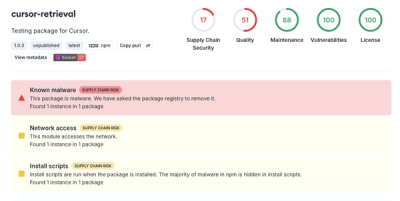
Security News
The Risks of Misguided Research in Supply Chain Security
Snyk's use of malicious npm packages for research raises ethical concerns, highlighting risks in public deployment, data exfiltration, and unauthorized testing.
create-hashicorp-lint-setup-ember
Advanced tools
Automatically sets up a HashiCorp linting configuration for Ember.js apps or addons
create-hashicorp-lint-setup-emberAutomatically sets up a linting configuration for an Ember.js app or addon using HashiCorp's eslint and ember-template-lint configs.
In the root folder of the app or addon you're working on, run the following command and follow the prompts:
yarn create hashicorp-lint-setup-ember
This will install the necessary dependencies and create or update the necessary files. Note that this does not install HashiCorp's prettier configuration, you will have to do that yourself as a separate step.
The .eslintrc.js file structure that is needed for this linting setup to work makes adding globals in the usual way difficult. Instead, if you want to add globals, create a file .eslintrc.globals.js that contains your eslint globals, which you can then require this file as needed in lower level .eslintrc.js files. For instance:
// .eslintrc.globals.js
module.exports = {
globals: {
MY_AWESOME_GLOBAL: true,
},
};
// addon/.eslintrc.js
module.exports = {
root: true,
extends: [
'@hashicorp/eslint-config-ember',
require.resolve('../.eslintrc.globals.js'),
],
};
// tests/.eslintrc.js
module.exports = {
root: true,
extends: [
'@hashicorp/eslint-config-ember/test',
require.resolve('../.eslintrc.globals.js'),
],
};
It installs the following packages:
Moreover, it sets up various .eslintrc.js files and one .template-lintrc.js file, depending on your answers to the prompts.
If you're setting up an addon, the files generated will be:
.
├── .eslintrc.js [eslint-config-node]
├── .template-lintrc.js
├── addon
│ └── .eslintrc.js [eslint-config-ember]
├── app
│ └── .eslintrc.js [eslint-config-ember]
└── tests
├── .eslintrc.js [eslint-config-ember/test]
└── dummy
└── config
└── .eslintrc.js [eslint-config-node]
If you're setting up an app, they will be:
.
├── .eslintrc.js [eslint-config-node]
├── .template-lintrc.js
├── app
│ └── .eslintrc.js [eslint-config-ember]
└── tests
└── .eslintrc.js [eslint-config-ember/test]
If you've selected to use TypeScript, the files will be set up with their respective TypeScript configurations, rather than the standard vanilla JavaScript configurations.
FAQs
Automatically sets up a HashiCorp linting configuration for Ember.js apps or addons
The npm package create-hashicorp-lint-setup-ember receives a total of 0 weekly downloads. As such, create-hashicorp-lint-setup-ember popularity was classified as not popular.
We found that create-hashicorp-lint-setup-ember demonstrated a not healthy version release cadence and project activity because the last version was released a year ago. It has 1 open source maintainer collaborating on the project.
Did you know?

Socket for GitHub automatically highlights issues in each pull request and monitors the health of all your open source dependencies. Discover the contents of your packages and block harmful activity before you install or update your dependencies.

Security News
Snyk's use of malicious npm packages for research raises ethical concerns, highlighting risks in public deployment, data exfiltration, and unauthorized testing.

Research
Security News
Socket researchers found several malicious npm packages typosquatting Chalk and Chokidar, targeting Node.js developers with kill switches and data theft.

Security News
pnpm 10 blocks lifecycle scripts by default to improve security, addressing supply chain attack risks but sparking debate over compatibility and workflow changes.